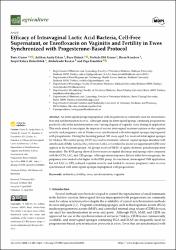Efficacy of intravaginal lactic acid bacteria, cell-free supernatant, or enrofloxacin on vaginitis and fertility in ewes synchronized with progesterone-based protocol

View/
Access
info:eu-repo/semantics/openAccesshttp://creativecommons.org/licenses/by/3.0/us/Date
2024Author
Güner, BarışErkan, Aslıhan Ayalp
Öztürk, Buse
Güner, Tevhide Elif
Kısadere, İhsan
Demirbilek, Serpil Kahya
Keskin, Abdulkadir
Frantisek, Zigo
Metadata
Show full item recordAbstract
An intravaginal sponge impregnated with progesterone is commonly used for estrus induction and synchronization in ewes. Although using an intravaginal sponge containing progesterone
positively affects the synchronization rate, varying degrees of vaginitis occur during its application.
This study aimed to investigate the impacts of various intravaginal treatment options on the vaginitis
severity and pregnancy rate in Merino ewes synchronized with intravaginal sponges impregnated
with progesterone. During the breeding period, 589 ewes, aged 2–6, received intravaginal sponges
for 14 days. The control group (CON) received no treatment, whereas vaginal sponges absorbed with
enrofloxacin (ENR), Lactobacillus plantarum (LAC), or Lactobacillus plantarum supernatant (CFS) were
applied in the treatment groups. All groups received 500 IU of equine chorionic gonadotropin intramuscularly. The ENR group showed lower scores in vaginal discharge and sponge odor compared
with the CON, LAC, and CFS groups. Although estrus responses did not differ between groups, the
pregnancy rate tended to be higher in the ENR group. In conclusion, intravaginal ENR application,
but not LAC or CFS, reduced vaginitis severity and tended to increase pregnancy rates in ewes
synchronized with intravaginal sponges impregnated with progesterone.
Source
Agriculture-BaselVolume
14Issue
4Collections
The following license files are associated with this item:


















